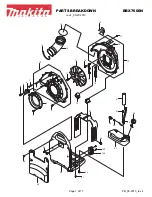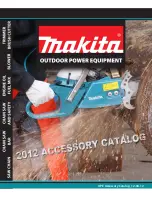
30
3. The bottom half of the housing can now be
removed.
4. The receiver print plate is in the top half.
5. See the drawing below for the setting to be
made
5. OPTIONS
Multiple transmitters
It is possible to monitor as many mares as possi-
ble at the same time using extra transmitters.
However, only one (green) transmitter with auto-
matic transmitter monitor may be used. All the
others must be in black housing.
Connecting an extra buzzer or tele-
phone dialler
If you want to install an extra buzzer or tele-
phone dialler, connection 5 on the receiver is
provided for that purpose. Use an extension lead
(25m) to connect this equipment. Connection 5
switches simultaneously with the alarm signal.
Warning: only connect original Birth Alarm
peripherals. If in doubt, consult your dealer.
On request, your 230 volt adapter connection
can be replaced by a connection to a 12 Volt
(car) battery.
6. FAQ
I get a false alarm…
It also might be caused by other transmitting sys-
tems in your area such as cordless telephones,
baby alarms etc. You can check this by leaving
the receiver on for some time without the trans-
mitter on the mare. If you still get an alarm, con-
tact your dealer.
I don’t get an alarm…
Set the receiver to mode (c) for testing purposes.
Ensure the transmitter and receiver are working
correctly by holding the transmitter in a vertical
position for at least 5 seconds. If the alarm does
not work, replace the battery and/or check
whether the receiver is on or off. Take care to
stay within the maximum transmission range. As
stated above this may be adversely affected by
high-tension power cables, electrical wiring,
other (non-approved) transmission equipment,
iron foaling boxes, concrete walls etc.
The transmitter is damaged…
Return the transmitter and receiver to us imme-
diately. We will test the transmitter for you and
replace any damaged parts.
Tips and tricks!
Problems with reception?
Make sure these items are not blocking the
antenna reception:
• Leaded windows
• Metal laminated or coated glass
• Closed metal blinds
• Concrete walls with steel reinforcement
• Mobile telephones
• Electrical domestic appliances
• Passing trams, scooters, and trucks
• Changes in the construction around the
house
• Steel construction in the shed or barn where
the signal is coming from.
IMPORTANT
All systems bought before 2006 are not compat-
ible with this system.
If you already have BIRTH ALARM components
(transmitter, receiver) in stock and wish to use
these in combination with this system, first check
if these are suitable, as only BIRTH ALARM com-
ponents working on 433 MHz-band, can be
combined with this system. Whether a BA- trans-
mitter or receiver works on 433 MHz, you can
see for example by the:
- type- and frequency indication (resp. H III-B
31
and 434 MHz) on bottom of transmitter and
rear of receiver.
- rubber antenna (both transmitter and receiv-
er)
- green LED on the transmitter (on old systems
this is red)
7. GENERAL
Warning: exposing the Birth Alarm to water is
disastrous for the sensitive technology inside
Birth Alarm.
You can avoid damage to the transmitter, for
example by making sure that the transmitter is
out of reach of other horses.
8. TIPS
A pregnant mare normally gives birth when there
is nobody around. This is a natural behaviour of
horses. A foaling stall (for a single horse) must be
at least 3.5 square metres and must not contain
any obstacles or protrusions which might dam-
age the transmitter and/or the horse.
It is well known that foaling out of doors is
always preferable for reasons of hygiene, space
etc. Warning: Avoid sloping or uneven ground if
you let the mare move around freely outside,
since sloping or uneven ground may have a neg-
ative effect on the function of BIRTH ALARM.
If the alarm sounds and the birth is about to hap-
pen, try to leave the mare alone by watching the
birth via CCTV or similar.
Check if the front legs of the foal are in the right
position and clean the mouth of the foal after
the head becomes visible. However try to leave
the mare alone as much as possible until after
the birth. The mare will get up by herself. In that
way the blood can still flow to the foal via the
placenta. After the mare stands up the umbilical
cord will brake at the weakest point, a few cen-
timeters from the foals belly.
Don’t have to much bedding in the stall. The
young foal will have trouble moving about in it.
Have some woodshavings and sand available
close to the stall. After the birth put some wood-
shavings on the wet spots in the bedding behind
the mare. If you are using straw in the stall
spread some sand on it. The sand will fall
through the straw on the stall floor and prevents
the foal from slipping when trying to get up.
Get the mare used to the barn lights you are
using during the birth by switching them on on
unusual times during the evenings before the
birth.
A perfect bedding can be made by using wood-
shavings in a layer of 10 cm. Prepare this bed-
ding about 2 weeks before the birth.
The advantage is that the mare doesn’t get
injured by this type of bedding. No slippery floors
because it absorbs the amniotic fluids.
The foal gets up easier and learns to walk faster
and easier than in a thick layer of straw.
As a result of this the foal is less likely to get
injured by repeatedly getting up and falling
down.
Things to know:
Birth Alarm is patented in the Netherlands and
has been on the market since 1990. Since its
introduction more than 80,000 foals have suc-
cesfully been born using this system.
Birth Alarm is used worldwide and is without a
doubt market leader in its area.
Even the very first systems are still being used
each year, to the full satisfaction of the users.
Using the Birth Alarm in combination with low
cost CCTV systems is a good alternative.















































